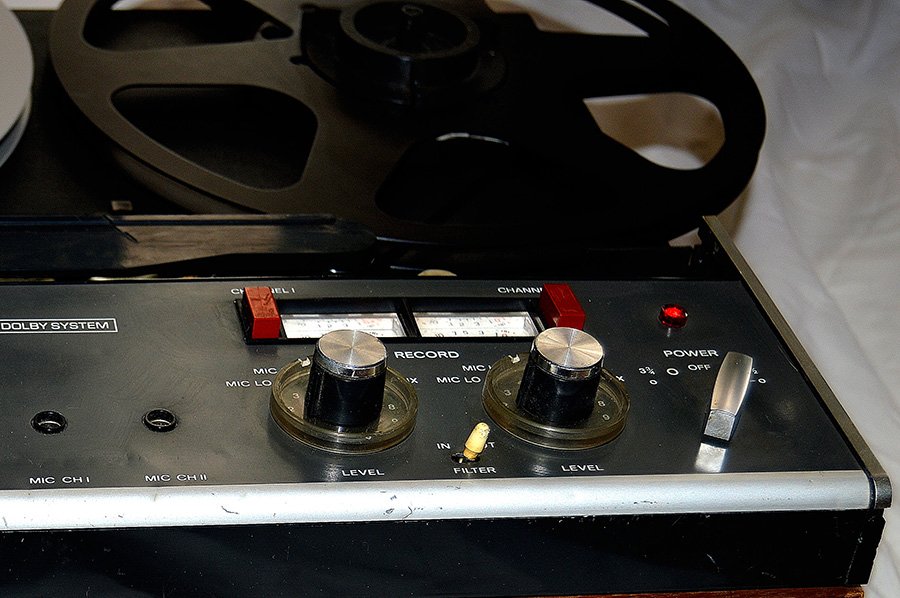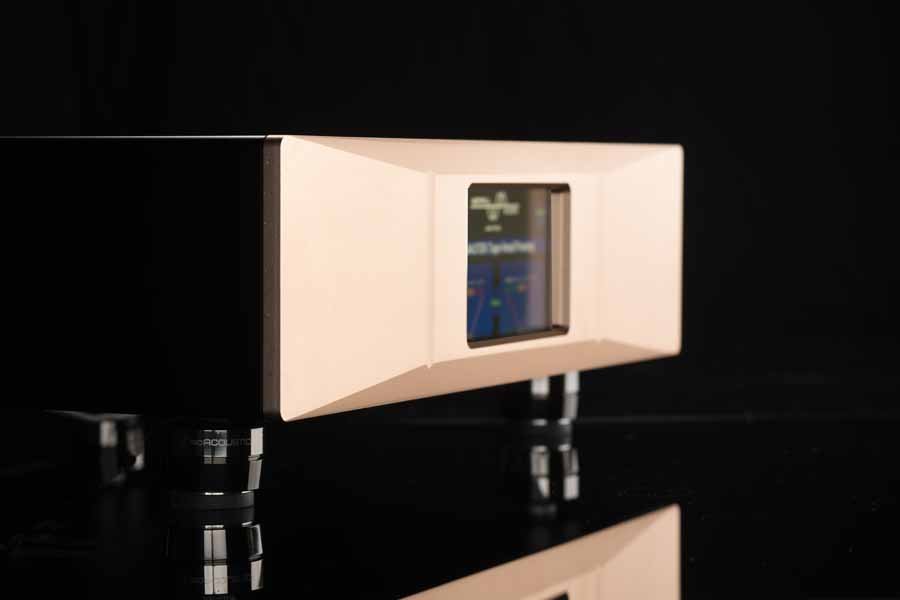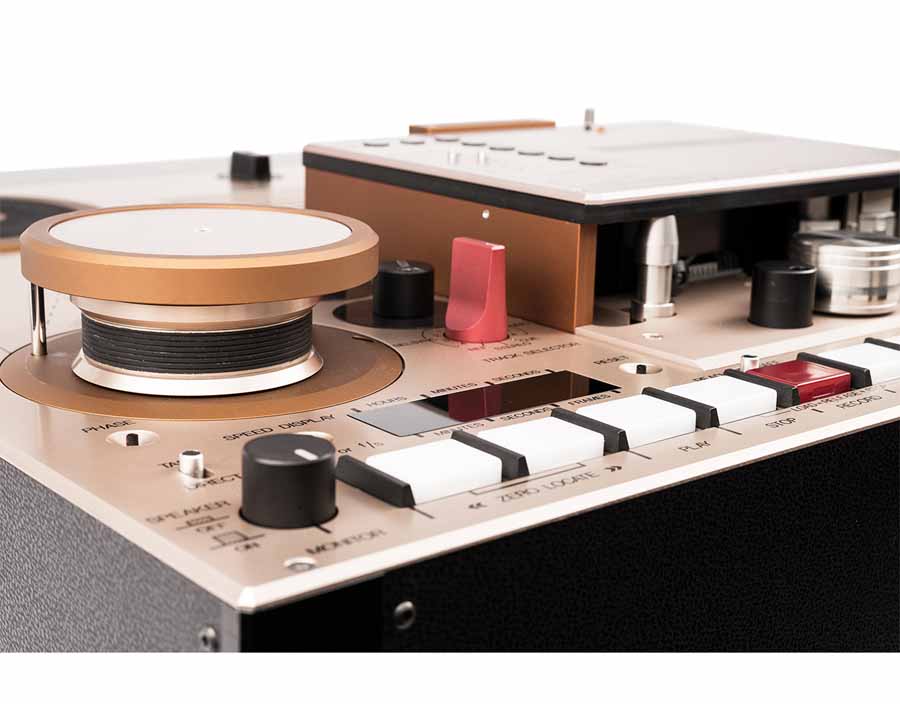Things are afoot in the world of reel 2 reels. Not only are there now at least 4 major companies producing reel to reel copies of famous master tapes, but very importantly after a long gap the Swiss tape recorder manufacturer Revox are bringing back the medium with a player based on the A700.
Like so much 21st century manufacturing it won’t be in the company’s home town, but this one will be made in Slovakia. The company had already set up an internet shop to sell high quality copies of original studio masters. At €298.00 for a single 10½ inch reel or two for €398.00 they are not cheap, but as serious audiophiles are beginning to realise that the ‘convenience’ of small discs or mini-SD cards don’t necessarily mean better sound quality, the format is making a striking recovery.
I began my expedition into reel to reels at the age of 10, buying an aged Fidelity ‘Play Master’ tape recorder, with 5 ½ inch reels at 3.75ips in mono. My bedroom morphed into my own radio station “Abbey Audio” where I relayed, using bell wire, radio programmes I made to my parents downstairs. Even my parents had speaking parts in radio plays I created, or requested their favourite music. My interest in reel 2 reels was influenced by Kenny Everett’s recording antics and working for a local talking newspaper. By the time I got into senior school I knew I wanted to work for the BBC, which as many of you know I finally achieved, where I could now get paid for playing with tape recorders. I am pleased to see the format gaining a new lease of life. The fact that only a tape player is planned is a shame, but as we have become quite lazy humans in recent years I guess a recorder is unlikely, certainly for the moment. Though rumour has it that the new player will be in part modular and a recording module will be made available.
However, all is not lost, as with eBay and other sources, getting your foot (or 10½ inches?) in the door with second-hand machines is very easy. The names ‘Revox’ and ‘A77’ are two of the most known in the hifi and professional audio world and the A77 is one of the most sought after machines, something I so, so wanted when I was young, though took until middle age before I finally got two of them. I now have a collection of 16 reel-to-reels of different makes and sizes.
Set up by Willi Studer in 1948 it began life making high-tension oscilloscopes, but in 1949 branched out into audio by modifying imported tape recorders from the USA, and developing their own tape recorder, named the Dynavox series. In 1951 ELA AG was founded by Willi Studer and Hans Winzeler, creating the Revox brand and the T26 tape recorder (based on the Dynavox). Given a choice between Studer or Revox tape machines is just like choosing between Teac and Tascam or Toyota and Lexus. Where Studer would win every time, Revox made every effort to ensure that the brand was the most sought after by the amateur audio recordist, generally having lower tape speeds, (wired) remote controls, no XLR connectors, and less utilitarian looks. Where the Revox brand still resides in Switzerland and Germany, Studer was absorbed into the Harman Soundcraft group in Potters Bar, near London, England in 2004 to specialise in mixing desks, including the very successful Vista series, as used by major broadcasting companies around the world including the BBC. Soundcraft itself is owned by Harman International Industries, an American company who also own brands such as the automotive division of B&O, AKG, Infinity, JBL and Mark Levinson.
Those new reel 2 reel tapes being sold at €298.00 are usually produced on the wonderful A80 and A800 machines, but my favourite is actually the smallest Studer machine, the A807, with features such as return to zero or “go to” memory locators.
Until the 1970’s home recording on reel 2 reels was a very common occurrence, with magazines such as “The Tape Recorder” showing you things like how to record the best sound from your blue tit at the bottom of the garden. Competing with Truvox, Brenell, Ferguson, Elizabethan, Akai and Sony, and professional companies such as Ferrograph and Telefunken, Revox was still seen as the best tape recorder to buy with your hard earned guineas, though often the most expensive. They began their famous “36” series with the A36, B36 and C36 and then their first stereo machine the D36. This coincided with the “37” series from Studer, just as the T26 did with the Studer A27. After the Revox G36 came the A77 in 1967, the latter largely based on the older machine though all-transistor rather than having 13 valves, and allowing 15ips for the first time. More noticeable it had a much more modern “box” shape with less “aged” rounded edges. This new machine also gave much more choice for the audio fan, available in 186 different permutations over the next 10 years of its production, with 400,000 units being produced. After the A77 would come the B77 (1977) and semi-pro PR99 (1982), both based on the A’ series. The very last Revox tape machines to be made were the C270 series in 1988.
What make the A77 so special are not only the good frequency response, low wow and flutter and good signal-to-noise level, but also its good design and bullet-proof build. It is a 3-head (erase, record, playback “ERP”) 3 motor machine, with both the capstan and reel motors being direct drive. The capstan motor was the excellent synchronous Papst motor used in the G36 which drives the tape at constant speed, and the two further motors provide back tension from the feed (left) spool and a constant take-up tension for the take-up (right) spool. Being direct-drive means that the only belt in operation is for the tape counter, connected to the take up motor. This not only makes maintenance easy (as someone who has regularly had to repair disintegrated and broken belts in lesser old machines, a process often requiring removal of numerous components and PCBs in order to get to them), but means performance and reliability is improved. Indeed, Revox strived to give good performance and reliability rather than offering bells and whistles such as things like auto reverse and memory location, etc.
The A77 came in quarter track (similar to that on a cassette tape, allowing two sides of tape recording) or half-track, giving better audio quality though at the cost of one-direction playing. The latter meant that you could edit your tape using spicing tape if there were sections of music or speech you needed to remove. For the perfectionist or professional sound recordist you could now store the tape “tail out”, meaning that it would need to be rewound in order to play from the beginning. The reason for doing this is because of inevitable low level print-though of the magnetised tape from one layer of the tape to the next which would now effectively be “after” the start of a sound rather than the silence or low-level sound before it. Imagine silence followed by a loud chord on the organ (eg Saint Saens Organ Concerto last movement). Any low level print-through of that chord would be hidden under the initial attack and decay of the music rather than sounding just before, which would be more audible.
The A77 could be ordered with various speed configurations, the most common being 3 3/4 ips (9,5 cm/sec) and 7 1/2 ips (19 cm/sec), though machines with 1 7/8 ips (4,75 cm/sec) or 15 ips (38 cm/sec) capability were also made. Models gave choice of NAB and IEC equalisation for playback from switches hidden under the long retractable panel below the tape path and the heads. You could even buy a version with Dolby B noise reduction, which I actually have in my own collection, but the Dolby on/off button and calibration controls mean there is no room for NAB/IEC switches, meaning it is only NAB. The high-speed versions are the most sought after. If you buy an A77, make sure you check headwear and the condition of the rollers and tape guides. Also check the brake hubs, and the incandescent bulb for the optical auto stop, which sometimes burns out.
The A77 came in four ‘makeovers’, with the Mk iii (1971-1974) being the most common and desirable with its more reliable electronics and precision mechanics. The relay controlled feather-touch push buttons give precise and quick action, and separate preamplifiers for record and playback, special circuitry to get rid of clicks and pops and regulated power supply were features we see regularly 40 years later. Whilst every budding tape fan would love a Studer or perhaps buy a Revox B77 or even PR99 with their more modern look and improved electronics, the A77 is still a very able and reliable machine that from the 1960’s secured the Revox name as the brand for quarter inch tape. I still use mine and expect it to last for another 40 years to come. The A77 will always remain the most important reel to reel of all time.
Janine Elliot
Read more Retro Bites with Janine Elliot




















































































































































































You must be logged in to leave a reply.